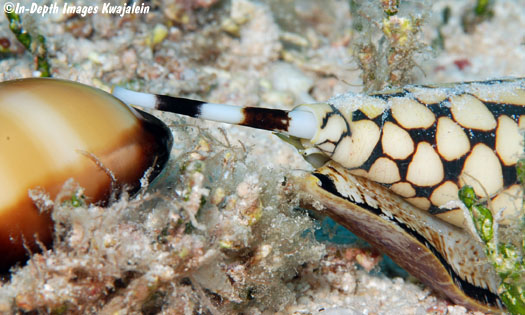Interactions
Marbled cone snails are found near coral reefs, which are
known for their wide diversity and abundance of numerous plant
and animal species. Most of these species are ignored by
C.
 marmoreus, since it is a carnivore
and doesn't consume plant matter, and is stenophagous, which means it feeds
on a specific food. For more information on the diet of this
animal and how it catches its food, visit the
Nutrition page.
Stenophagous
organisms have little or no competition with
other organisms. It therefore occupies its own ecological
niche, and more species of cone snails can inhabit a single
region. The coral itself serves as the snail's
home, along with the rock ledges they
grow on and the sandy substrate they lay upon.
marmoreus, since it is a carnivore
and doesn't consume plant matter, and is stenophagous, which means it feeds
on a specific food. For more information on the diet of this
animal and how it catches its food, visit the
Nutrition page.
Stenophagous
organisms have little or no competition with
other organisms. It therefore occupies its own ecological
niche, and more species of cone snails can inhabit a single
region. The coral itself serves as the snail's
home, along with the rock ledges they
grow on and the sandy substrate they lay upon.
Although C. marmoreus is a predacious organism, that
doesn’t mean it is free from becoming prey itself. Crabs
similar to the
Red Rock Crab, other crustaceans, and
even other snails often consume the marbled cone snail.
The architechture of its shell is very beneficial under these
circumstances, because the crabs have a hard time grasping its
cone shape. This is just one of many
adaptations this particular snail
has developed to become more successful.
snails often consume the marbled cone snail.
The architechture of its shell is very beneficial under these
circumstances, because the crabs have a hard time grasping its
cone shape. This is just one of many
adaptations this particular snail
has developed to become more successful.
Another interaction that takes place with this snail involves
humans. Shell collecting is a very popular hobby, and the
marbled cone snail is a great addition to any collection.
Its bright and distinct coloration provide incentive to find
and/or photograph its beauty.
Continue to Venom Facts
Return to Home
Visit MultipleOrganisms.net
Visit the UW-La
Crosse Website
Contact Information